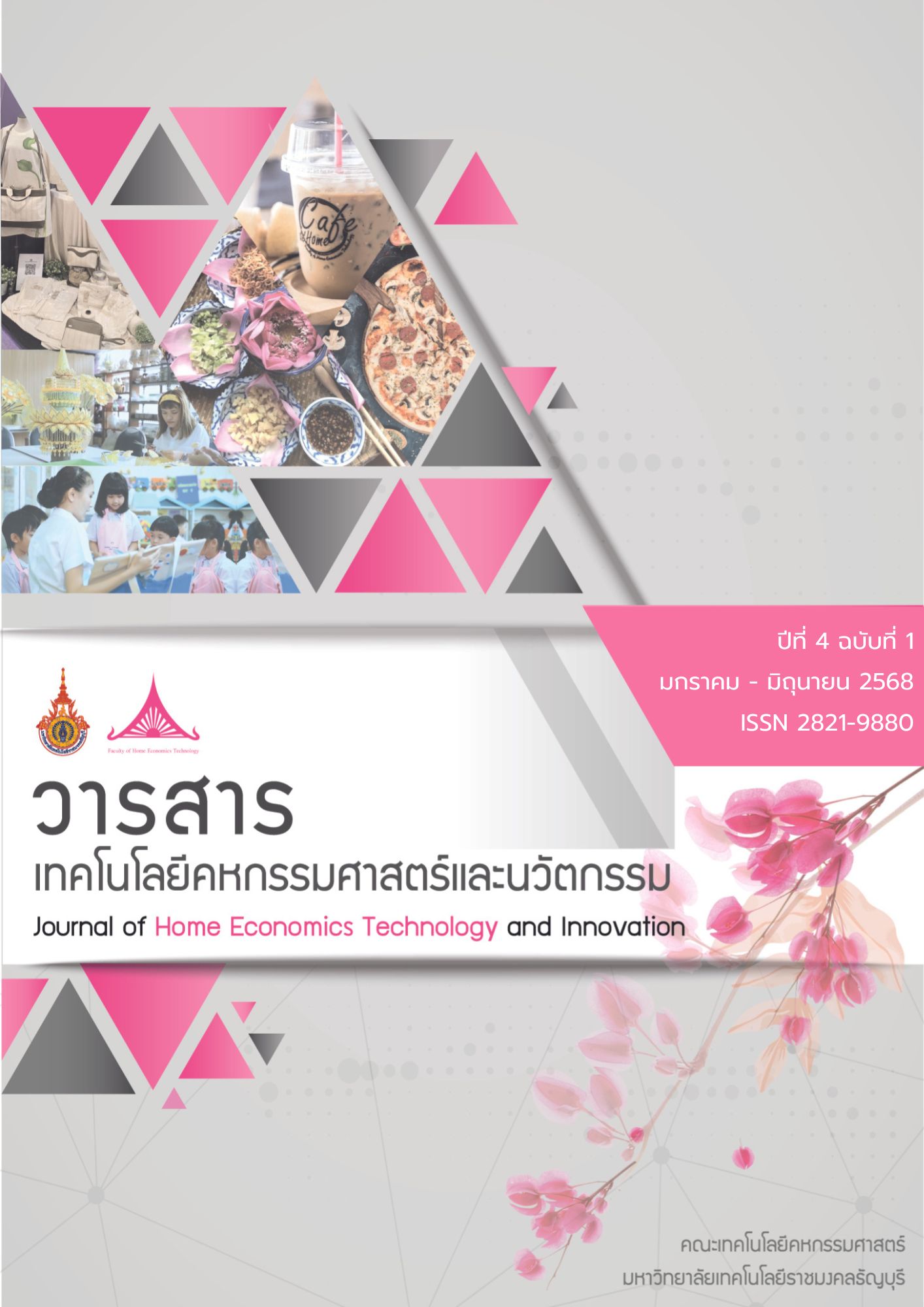Effects of adjustment endocarp of Nam Dok Mai mango for handicraft products
Main Article Content
Abstract
This research aimed to study the appropriate process for conditioning the endocarp of the Nam Dok Mai mango and to test its physicochemical properties for use in creating handicraft products. The factors studied included the duration of soaking in a glycerin solution at a ratio of 1 part glycerin to 3 parts clean water, with three different soaking periods: 2, 4, and 6 days. The experiment followed a completely randomized design (CRD) with three treatments in total. The study results found that the inner wall of Nam Dok Mai mango was soaked in glycerin solution for 4 days, which was the most suitable soaking duration for developing handicraft products. The treated endocarp exhibited a moisture content of 8.02 ± 0.02%, a hardness of 79.90 ± 0.78 newtons, and a thickness of 1.45 ± 0.03 millimeters. Additionally, the endocarp was smooth and strong, making it suitable for use as a raw material in forming various types of handicraft products.
Article Details
Articles published are copyright of the Journal of Home Economics Technology and Innovation. Rajamangala University of Technology Thanyaburi The statements contained in each article in this academic journal are the personal opinions of each author and are not related to Rajamangala University of Technology Thanyaburi and other faculty members at the university in any way Responsibility for all elements of each article belongs to each author. If there is any mistake Each author is solely responsible for his or her own articles.
References
ธนวรรณ ทาวนอก. (2565). การออกแบบและพัฒนาผลิตภัณฑ์โคมไฟจากเศษไม้เหลือใช้ จังหวัดเพชรบูรณ์.วารสารการบริหารนิตบุคคลและนวัตกรรมท้องถิ่น, 8(9), 191-193.
ธำรงเจต พัฒมุข. (2563). เอกสารคำสอน ชุดวิชา 93467 การจัดการการผลิตไม้ผลเชิงธุรกิจ. สาขาวิชาเกษตรศาสตร์และสหกรณ์มหาวิทยาลัยสุโขทัยธรรมาธิราช: นนทบุรี.
บริษัท ควอลิตี้ พลัส อินเตอร์เทค จำกัด. (2567). เมล็ดมะม่วงกับเครื่องสำอาง. สืบค้นเมื่อวันที่ 21 กรกฎาคม 2567 จาก https://www.qualityplus.co.th/quality-plus-deep-technology/.
พรเทพ ศรีธนาธร. (2567). สถานการณ์มะม่วงไทยและแนวโน้มความนิยมในสหภาพยุโรป สหภาพยุโรป. วารสารสำนักที่ปรึกษาการเกษตรต่างประเทศประจำสหภาพยุโรป, 27(1), 2-3.
ศุภมาศ กลิ่นขจร. (2564). วิจัยและพัฒนาการขยายผลผลิตภัณฑ์เพื่อสุขภาพเชิงพาณิชย์. รายงานแผนงานวิจัยย่อย. กรมวิชาการเกษตร.
สุภาวรรณ วงค์คําจันทร์. (2556). การจัดจําแนกมะม่วง. มะม่วงการผลิตและเทคโนโลยีหลังการเก็บเกี่ยว. ศูนย์นวัตกรรมเทคโนโลยีหลังการเก็บเกี่ยว สํานักงานคณะกรรมการการอุดมศึกษา (สกอ.) น. 3-14.
FAOSTAD. (2015). F. and A. organization of the United Nations. FAO. Retrieved from http://faostat.fao.org/site/339/default.aspx.
Gunstone, F.D. (2006). Minorspecialtyoils. pp.91-126. In. Nutraceutical and Specialty Lipids and Their Co-Products. CRC Taylor & Francis Group, Florida, USA.
Jahurul, M., Zaidul, I., Ghafoor, K., Al-Juhaimi, F., Nyam, K., Norulaini, N., et al. (2015). Mango (Mangifera indica L.) by-products and their valuable components: A review. Food Chemistry, 183, 173-180.
Lee, K., et al. (2020). Effect of glycerol treatment on cellulose structure in fruits. Food Processing Technology, 15(2), 102-110.
Palaniswamy, K.P., Muthukrishna, C.R., and Shanmugavelu, K.G. (1974). Physicochemical characteristics of some varieties of mango. Indian Food Packer, 28(5): 12-18.
Rodriguez, M., et al. (2019). Structural changes in plant cells under osmotic dehydration. Journal of Agricultural Research, 18(6), 890-897.
Smith, J., et al. (2018). Hygroscopic properties of glycerol in plant tissue. Journal of Food Science, 23(4), 567-574.
Tharanathan, R., Yashoda, H., & Prabha, T. (2006). Mango (Mangifera indica L.), “The King of Fruits” An overview. Food Reviews International, 22(2), 95-123.


